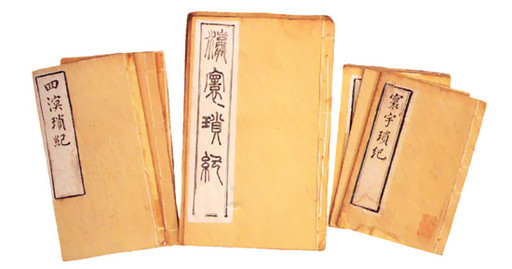
. > RESEARCH > LITERATURE
Literature periodicals have historical value
Author : ZHANG QINGLI Source : Chinese Social Sciences Today 2017-01-09

Around the World (middle) issued in 1872, later renamed Siming Gleanings (left) in 1875 and World Wide News Gleanings (right) in 1876 was the first literature periodical in China.
Chinese contemporary literature will commemorate 100 years of existence in 2017. As the major carrier and form of dissemination for Chinese contemporary literature, literature newspapers and journals bore witness to its origin and development, providing valuable materials for related research. However, as time passes, some of these materials were lost while others were hard to read. Finding ways to utilize these materials became a focus in the academic community.
Literature newspapers and journals differentiate contemporary literature from ancient Chinese literature, said Bao Guohua, deputy dean of the School of Arts at Tianjin Normal University. He said the emergence of literature newspapers and journals have brought fundamental changes to the production, spread and acceptance of Chinese literature. Literary works were often first published in newspapers, in contrast to ancient literature which only circulated on a small scale. This form also accelerated its spread and cut down on the amount of time readers had to wait to receive new works, while broadening the audience base and expanding the influence of literary works. In addition, as carrier of literary works, newspapers and journals promoted the emergence of professional writers.
Liu Zengren, a professor from Qingdao University, gathered information on 10,207 kinds of literature journals over 77 years from the first journal Around the World was created in 1872 to the foundation of the People’s Republic of China in 1949. Liu Jincai, a professor from the School of Arts at Henan University, said many important literature journals emerged in the formation period of Chinese contemporary literature. Different literary organizations and schools of thought create their own journals showing their unique literary ideas.
Among these journals, La Jeunesse had the greatest impact on Chinese contemporary literature. Liu Jincai said the transformation of ancient to contemporary literature was clearly seen in the development of the journal: Such as the use of colloquial language in poetic creation, its replacement of the classical writing style, and the adoption of new punctuation marks.
Such a large number of literature newspapers and journals provided rich primary sources for research on Chinese contemporary literature. Bao said Chinese contemporary writers would first publish their works in newspapers in serial format, and then these articles would be published in separate collections. Therefore, newspapers and journals helped to maintain the originality of those works and place their relevance to the historical background in context. Similarly, Liu Jincai pointed out that compared with articles published in newspapers, separate collections deprived the public and reduced the quantity of historical materials. It is hard to establish historical relevance from isolated articles in collections, he said.
In addition, literature newspapers and journals have their own capital background, market awareness, conception of editing, literature taste and layout design. Thus besides their historical value, these primary sources also provide material for other fields, such as the history of thought, art, dissemination and publication.
Writers and researchers of Chinese contemporary literature have a long academic tradition of collecting literature newspapers and journals. In 1935, Mao Dun, a celebrated writer, introduced the trends of the “new literature” promoted by the May 4th movement in 1919 in its first decade in Chinese New Literature Collection: Fiction Volume One: Introduction. A Ying listed the names of those influential journals and gathered forewords to these periodicals in Chinese New Literature Collection: Historical Materials: Index. Also, during the 1950s to 1960s, the Zhonghua Book Company published Zhang Jinglu’s Contemporary Chinese Publication Historical Materials and its supplement. Periodical Directory of Chinese Contemporary Literature published by the Tianjin People’s Press in 1988. It collected 276 kinds of periodicals, and was regarded as the first authorized reference book in the field.
Entering the 21st century, the collection and research of these newspapers and journals continued this trend. In 2010, scholars from Nanjing University, Renmin University of China and East China Normal University edited the New Edition of Periodical Directory of Chinese Contemporary Literature based on A Ying’s efforts, adding to the 657 kinds of periodicals. Liu Zengren’s Historical Essay on Chinese Contemporary Literary Periodicals and Information on Literary Periodicals 1972-1949 published by the Qingdao Publishing House also drew much attention. However, Liu suggested that collection is only the first step to research. Materials are fragmented but related research requires deepened thoughts, he said.
Ye Shengtao made Chinese fairy tales from a wilderness
Ye Shengtao (1894–1988) created the first collection of fairy tales in the history of Chinese children’s literature...
-
How northern ethnicities integrated into Chinese nation
2023-09-18
-
Mogao caves
2023-09-12
-
Mogao Grottoes as ‘a place of pilgrimage’
2023-09-12
-
Time-honored architectural traditions in China
2023-08-29
-
Disentangling the civilizational evolution of China
2023-08-28
-
AI ethics in science fiction
2023-08-23













 2011-2013 by www.cssn.cn. All Rights Reserved
2011-2013 by www.cssn.cn. All Rights Reserved